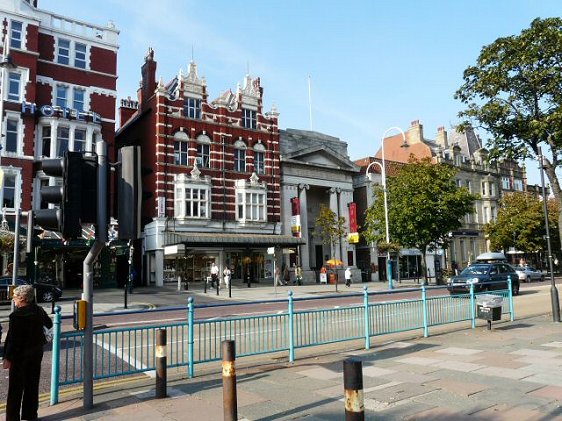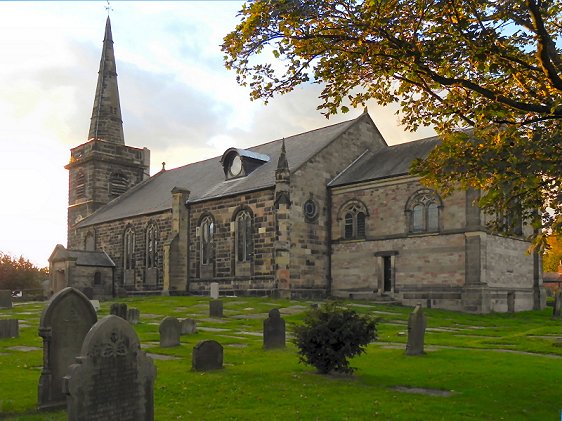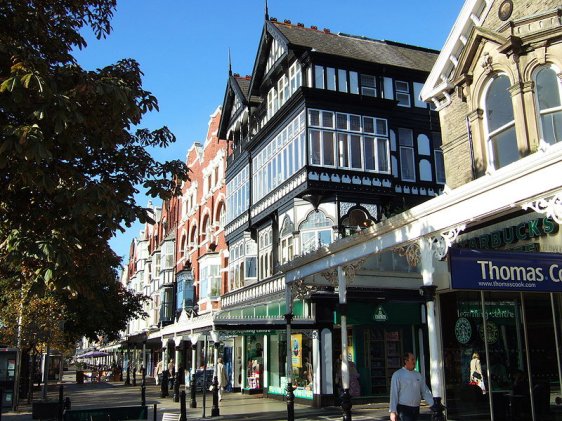 Southport Pier: Source: https://commons.wikimedia.org/wiki/File:Southport_Pier_6.JPG
Southport Pier: Source: https://commons.wikimedia.org/wiki/File:Southport_Pier_6.JPGAuthor: Small-town hero

Southport is a seaside town in the Metropolitan Borough of Sefton, on the northern part of Merseyside, England. With a population of 95,000 people, it is the 11th most populous settlement in North West England.
Southport is quite young by English standard. It was only founded in 1793, when a hotel was built there. Before that however, human presence has been recorded in the area going back to the Middle Stone Age.
 Southport, Merseyside, England: Source: https://commons.wikimedia.org/wiki/File:Lord_Street_Banks_-_geograph.org.uk_-_982135.jpg
Southport, Merseyside, England: Source: https://commons.wikimedia.org/wiki/File:Lord_Street_Banks_-_geograph.org.uk_-_982135.jpgAuthor: Gerald England

Although the Romans passed by this area, the earliest permanent settlements were established during the Viking era, between the 9th and 11th centuries. They left their mark in the form of place names to some of the neighborhoods in the area, one of which were recorded in the Domesday Book of 1086 as Otergimele.
William Sutton, the proprietor of the Black Bull Inn in Churchtown, is credited as the founder of Southport. Seeing the potential created by the newly built canals in the area, he decided to establish a seaside hotel just 6 km (4 mi) from the newly constructed Leeds and Liverpool Canal, arranging transport for visitors from the canal to his hotel. He became successful quickly, and soon others followed suit, building more hotels in the area.
 St Cuthbert's Church, Churchtown, Southport: Source: https://en.wikipedia.org/wiki/File:St_Cuthbert%27s_Parish_Church,_Churchtown_-_geograph.org.uk_-_2091966.jpg
St Cuthbert's Church, Churchtown, Southport: Source: https://en.wikipedia.org/wiki/File:St_Cuthbert%27s_Parish_Church,_Churchtown_-_geograph.org.uk_-_2091966.jpgAuthor: David Dixon
 Southport earned a reputation of being a more refined resort compared to neighboring Blackpool. Its geographic local also enabled it to draw tourists from Liverpool and Manchester, the two main cities in the area. The first true pleasure pier in Britain, Southport Pier, was built in 1859. Today it is a Grade II listed heritage structure.
Southport earned a reputation of being a more refined resort compared to neighboring Blackpool. Its geographic local also enabled it to draw tourists from Liverpool and Manchester, the two main cities in the area. The first true pleasure pier in Britain, Southport Pier, was built in 1859. Today it is a Grade II listed heritage structure.Among the famous residents of Southport included Louis-Napoléon Bonaparte, who dwelled at Lord Street while in exile from 1846 to 1848, before his eventual return to France as President and subsequently as Emperor.
As with so many seaside resorts in Britain, Southport suffered a decline in the 20th century, when local sea resorts went out of fashion against cheaper destinations in Spain. It was historically part of Lancashire until 1971, when it successfully lobbied to be made part of the planned metropolitan county of Merseyside. When Merseyside was formed, Southport became part of the Metropolitan Borough of Sefton.
Visiting Southport
From Liverpool take the A565 road heading north. From Manchester take the A580 road heading west till intersection with the A570 road. Turn right and head north on the A570 road till you reach Southport. Lord Street, Southport: Source: https://en.wikipedia.org/wiki/File:Lord_Street,_Southport.JPG
Lord Street, Southport: Source: https://en.wikipedia.org/wiki/File:Lord_Street,_Southport.JPGAuthor: Small-town hero

Places of Interest in Southport
- Hesketh Park: Public park on the north end of Lord Street in Southport.
- Lakeside Miniature Railway: Pleasure railway first built in 1911.
- Lord Street: Main shopping street of Southport, once the address for Napoléon III, who later returned to France as Emperor.
- Meols Hall: Historical manor house dating to the 12th century though most parts rebuilt in the 1960s.
- Model Railway Village: A model train village which opened in 1996.
- Pleasureland Southport: Amusement part that operated from 1912 to 2006, closed for close to a year, then reopened in 2007.
- Southport Botanic Gardens: Botanical garden in the village of Churchtown, Southport.
- Southport Pier: The first pleasure pier built in Britain.
- Splash World: Indoor water park.
- St Cuthbert's Church, Churchtown: Anglican parish church of the Diocese of Liverpool.
- The Round House: An Art Deco-style house built in 1924 by local builder Luke Highton to fulfill his dream of owning a house with a rotunda.
 Latest updates on Penang Travel Tips
Latest updates on Penang Travel Tips

Copyright © 2003-2025 Timothy Tye. All Rights Reserved.

 Go Back
Go Back